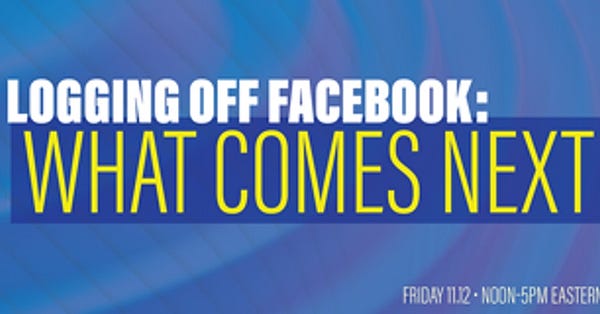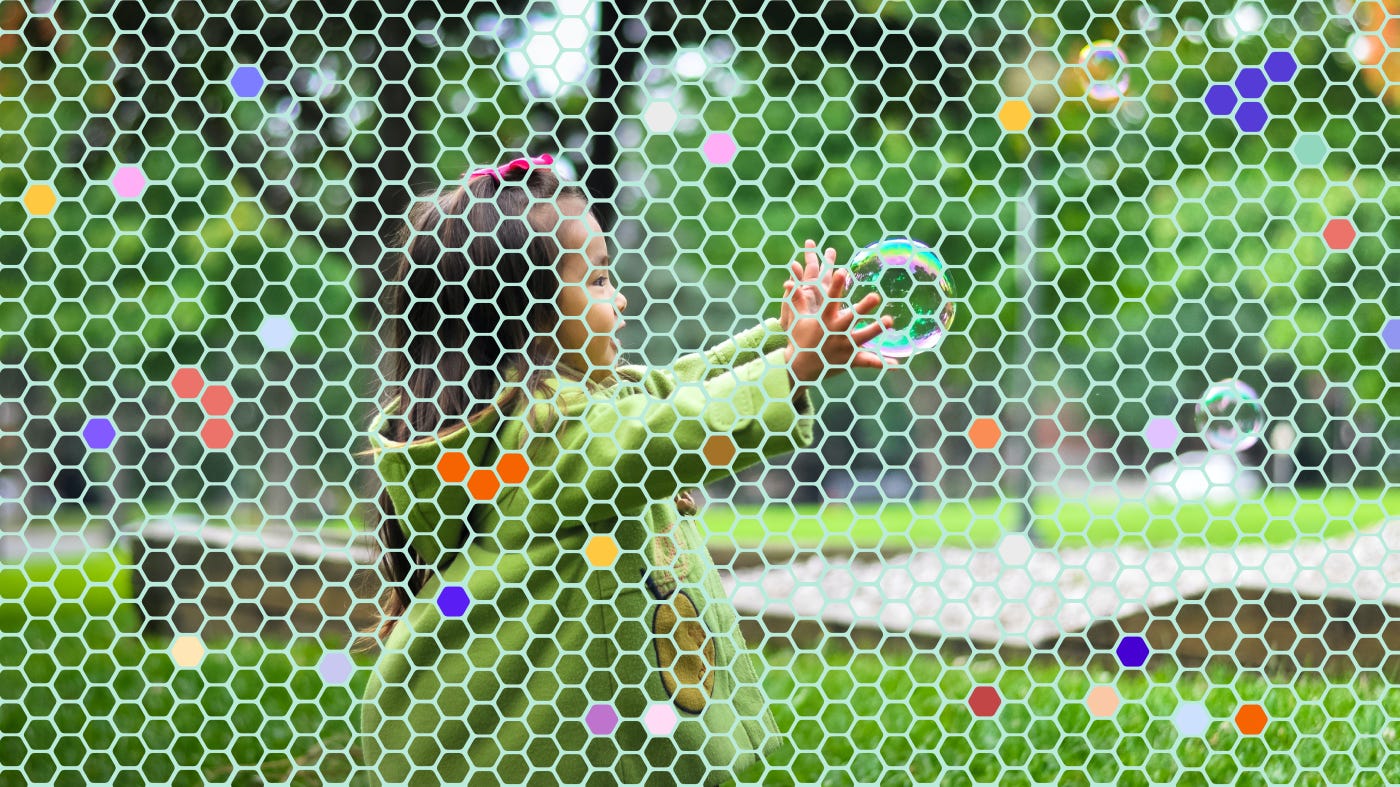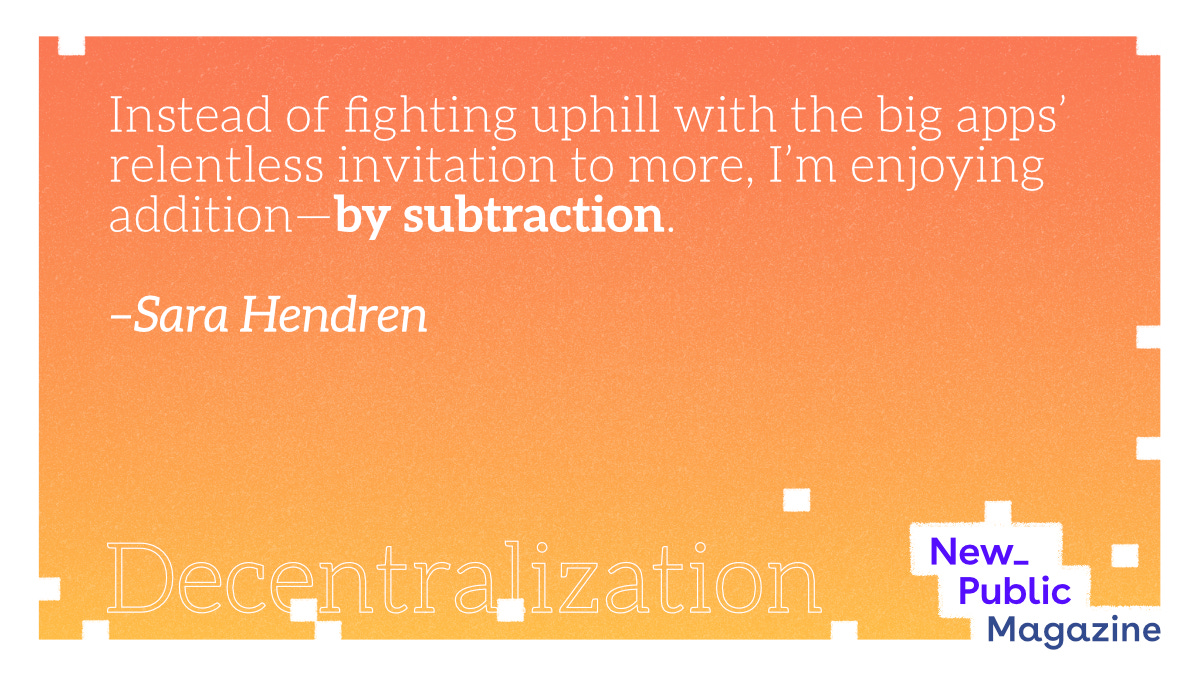🔑🚪 Discord and the boon of private social networks
It’s larger than ever on the strength of small groups
🔍 Better Know A Concept: Calm Technology
📖 Read an excerpt of Sara Hendren’s New_ Public Magazine article
When we talk about “social media,” we’re often talking about the huge platforms—public networks where anything can go viral and meaningful context is wafer thin or nonexistent. But there can be unexpected virtue in using private social networks. New_ Public contributing editor Sara Hendren, who is an artist, design researcher, writer, and professor, explores this in “Care is not an infinite scroll,” her article for New_ Public Magazine, excerpted below. Sara explains how finding a “simpler, more intimate” private alternative to Instagram yielded unexpected benefits. I think she’s on to something, and I’d like to consider another platform that gets comparatively little attention, but is blazing a path that deserves examination: Discord.
If you’ve never used it, Discord looks and works very similarly to Slack, with groups organized into “servers” and text-based discussion channels organized by topic. There is also functionality for video and audio chat. Though created in 2015 largely for online gamers, different groups have migrated to it over time, including influencers, creators, fanfic writers, artists, and fringe communities like white supremacists and cyber criminals. Of course, because Discord is private, it’s hard to know exactly how much extremism, crime and harassment is taking place on its servers.
The platform has put more resources into moderation, and has since upped its transparency and moderator certification efforts. Meanwhile, the pandemic arrived, and Discord rebranded away from gaming—gaining a reputation as an ad-free, chat-based private venue to build and grow friendships, adding tens of millions of users last year.
Discord now has 150 million monthly users, nearly triple their user base in 2019. Remarkably, according to CEO Jason Citron, “Most people on Discord are in invite-only servers that have less than 30 people in them.” Discord’s explosive growth has been fueled by millions of small, private networks, including several I belong to.
Early on in the pandemic, my wife had the foresight to set up a Discord server for our local friend group here in DC. I don’t use notifications, or follow every channel religiously, and my wife tends to ignore my beloved “plants” channel. If I miss a few days it's easy to catch up on everything in a few minutes. But it has been an incredible lifeline through these volatile years. Whether as a place to rant about work (never me, boss 😉), track Covid news, or plan Zoom happy hours, the server allowed us to feel close and connected when we didn’t feel safe being physically near each other. We’ve even had a friend move across the country, and she’s been able to stay connected as much as she likes. As Sara writes in her piece:
I find the social bindery of more frequent interaction with a smaller set of people—the updates on the earrings they chose, or the “post”-Covid vacation planned and abandoned or, yes, the things their kids say—earns us both an open line of communication for getting through the big challenges together.
Often at New_ Public, we go back to Dr. Elinor Ostrom and her call of “No panaceas!” Discord is working great for my friends right now, in this moment, but it clearly isn’t a blanket solution for every group. I doubt it will play the same role in my life once the pandemic is a distant memory. And it does take work: New_ Public set up a Discord server for our festival in January, but we haven’t figured out how to sustain it, or make it into a real community. (Do you have ideas about what we should do with it? Comment below.)
Not-so-public, digital spaces demand more contemplation, and will inevitably serve an important role in the next generation of social media. My guess is it’ll be in these smaller spaces, not the big public platforms, where we’ll build some of our most valuable infrastructures of care.
This week we're kicking off a new feature. If a concept keeps coming up, or we think it's a particularly good one that could use a little unpacking, we'll take a closer look here, in "Better Know A Concept." Let's start with calm technology.
Calm Technology
The background: This one goes back to Xerox PARC in the mid ‘90s, when researchers like Mark Weiser and John Seely Brown were writing incredibly prescient papers about what would come next in tech. They argued that as personal computing becomes ubiquitous, it may become unreasonably demanding on humans. For them, your devices should only do what you want them to do, when you want them to do it, and not automate away any of your humanity. More recently, author and researcher Amber Case popularized the concept and applied it to contemporary tech.
In action: Case writes on the Calm Tech site, “If a technology works well, we can ignore it most of the time. A teapot tells us when it is ready, and is off or quiet the rest of the time. A tea kettle can be set and forgotten, until it sings. It does not draw constant attention to itself until necessary.”
In digital public spaces: Last week, in talking about how Facebook’s design process led to the creation of a monster they cannot control, I suggested: “What if, in creating the next generation of digital public spaces—including the new ones that Zuckerberg wants to make—we choose to value calm technology, or center design justice principles?” Sara, in her piece, gets a glimpse at what this might look like in action on the app Notabli, which she describes as “an unapologetically modest interaction.” I experience something similar in my friend group’s Discord. There’s never any anxiety about keeping up. As Mark Weiser wrote in 1993, “A good tool is an invisible tool… you focus on the task, not the tool.” Instead of “Oh, a new Instagram notification,” the calm technology version would allow you to think, “I want to check in with my friends.”
Care is not an infinite scroll
How a slow app made my relationships stronger
Sara Hendren
It would have been in my kids’ middle-grade years—something like ages six, seven, eight?—when they first properly observed Instagram over my shoulder. We’d be on the couch, pasta boiling in the nearby kitchen, and they’d hang their little elbows around my neck or maybe fold into a half-sit on my lap. That was a developmental era with bright bursts of consciousness, big leaps in abstract reasoning, and a bare-bones sense of numeracy. But then—simple numbers turned out to be all they needed to understand social platforms. “Wow, Mama,” they’d say. “43 likes!” They had internalized Instagram’s deepest logic. More is nearly always more.
In the years since that little-kid parenting era, I’ve asked myself—the way so many of us have—whether more is what it’s cracked up to be. And I don’t just mean the self-evidently hollow offering of “likes.” There are all kinds of numbers that animate apps on the scale of Instagram or Facebook, reinforcing the algorithmic idea that bigger is better—or that bigger is inevitable, anyway. It took me a while to figure out that I needed something simpler, more intimate, and I got it in an unexpected way. I started using an app that’s officially marketed to families, and it became the digital social experience I’d been hoping for—not just as a parent, but as a person.
Notabli is not the kind of self-announcing refusenik tech targeted to folks who are outraged about the big social giants, who want to go rogue—or even just go weird or experimental. Notabli is an approachable and minimalist app for privately sharing, archiving, and easily printing digital images—led, as the app often notes, by an interest in “the kids you love!” It’s marketed as a convenient way to keep images of children far away from the public (or even the slippery semi-private) internet, and as a way to build the 21st century form of the family scrapbook.
Read the rest at New_ Public Magazine
Log Rolling
For more on Dr. Ostrom, and about New_ Public in general, listen to our Co-director Eli Pariser on Baratunde Thurston’s podcast How to Citizen. Eli says that he’s motivated by wanting his children to grow up in digital public spaces where they can say, "oh, it is possible to have a good conversation with strangers online that doesn't devolve into all of us calling each other Nazis." Listen to the whole conversation here.
Also, friends of New_ Public are organizing an unconference next Friday, called “Logging Off Facebook: What Comes Next?” They describe it as an “Event on what is next for technologists, policy makers, and organizers who are looking to hold Facebook accountable & find alternatives.” Advance registration required.


Query Log
Slack now reports much higher revenue than Discord and was purchased by Salesforce for $27.7 billion, which is more than double Discord’s projected value. If Discord has 150 million monthly average users, how many users does Slack have?
Finding the perfect gif,
Josh
Illustration and design by Josh Kramer
New_ Public is a partnership between the Center for Media Engagement at the University of Texas, Austin, and the National Conference on Citizenship, and was incubated by New America.






I mean I love discord. The real issue that discords have is a reason to communicate. I've tried to set them up for events and groups. Older folks don't always want to join because they are luddites. Other folks don't want to join because they just aren't good with tech or use too many already. But for folks that are really motivated to organize around an idea or an issue, it's really great. That's why it works for gaming I think, because games are knowledge and achievement oriented so people are driven to share knowledge online for some pretty standard rewards. I've seen it break down in climate communities because the roles and needs are less defined. There are also people who will just spam ideas without putting the work in to get them done, while the people who are busy working actually stay silent.
I think the fact that you have a magazine going consistently is actually really good. People can chime in and talk about stuff. And you can also gauge what people are interested in by checking in on the discord occasionally. Would love to be invited
Building a Discord community, perhaps look into “Bounties” to reward people for building the community/org. It’s sort of a new way to work, people can choose based on interest/availability and work in spurts. Otherwise AMA or happy hours on voice channel scheduled weekly?